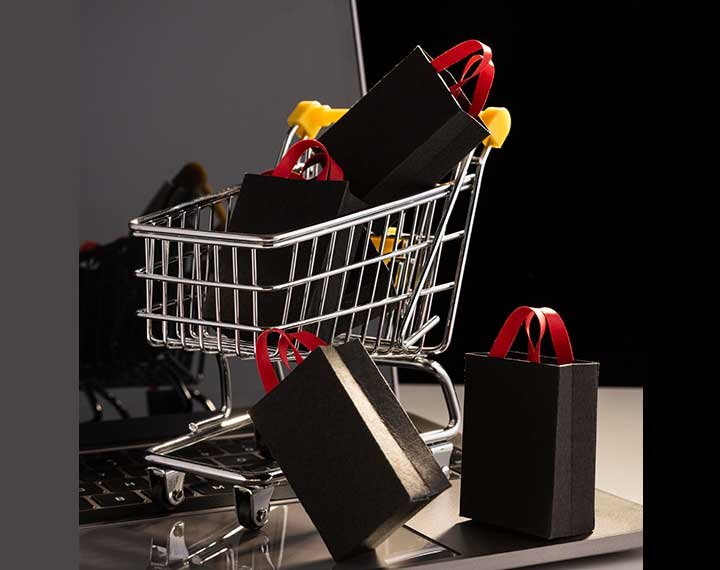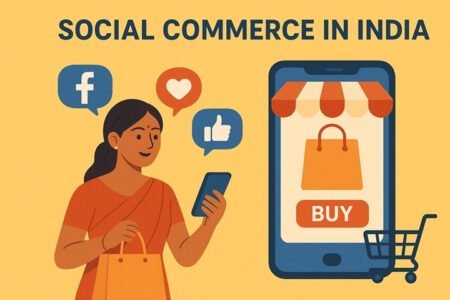
E- Commerce market opportunities
E- commerce has come a long way since its inception in the 20th century, driven by technological advancements and customer demands, and shows no signs of slowing down. E-commerce saw a significant surge during the COVID-19 pandemic, as lockdown and social distancing measures forced people to turn to online platforms for all their needs.
E – commerce has made life simpler for consumers, where they are no longer confined to store hours and are not required to travel. They can shop from their home, at their own convenience. Consumers can also access a vast range of products from around the world. They can check prices, read product reviews and compare features across platforms, at their fingertips to make an informed decision.
According to a Forbes article from March 15, 2022, Americans spent $1.7 trillion online during the COVID-19 pandemic, which was $ 609 billion more than in the two years before COVID-19 according to data from Adobe.
On a global scale, with the advent of the internet and digitization of modern life, consumers all over the world are opting to shop online. The rise of 5G further enhances the digital experience. According to reports, over 55% of internet traffic comes from mobile devices.
In the last five years, technological advancements like, Artificial Intelligence (AI), Machine Learning (ML), Augmented Reality (AR), Interactive Virtual Reality (VR) and 360-degree views, are significantly transforming the e- commerce industry.
Artificial Intelligence and Machine Learning are revolutionizing the e- commerce sector by analyzing vast amounts of data and providing insights to improve the customer’s experience. It also creates a personalized shopping experience for the customer by analyzing the customers behavior preferences and buying patterns. These technologies can anticipate a customer’s purchasing preference, allowing retailers to curate highly personalized product recommendations. It can also track and analyze the customers browsing and buying habits, identifying patterns over time. If a customer adds an item to their cart and leaves the website, the system sends an automated email reminding them of what was left behind. This is known as abandoned cart emails, which are a crucial part of ecommerce strategies, as they help recover lost sales and boost conversion rates. AI and ML technologies are also used to notify customers about inventory changes and enhance customer service through chatbots.
On the other hand, Augmented Reality allows shoppers to virtually try on clothes, Apparels and Footwear, Furniture and even home decor, while 360- degree gives a detailed look of the product from different angles. Virtual Reality videos take it up a notch, by offering a fully immersive experience, allowing customers to explore virtual stores or product demonstrations in a more life like manner. Amazon, the leading large-cap e- commerce website worldwide, has integrated these immersive technologies, enhancing the customer experience.
According to Omniconvert, the top 7 industries expected to see significant growth, shaping the future of online purchases are; Food – annual growth rate of 6.58% by 2028, Fashion– annual growth rate of 8.94% by 2029, DIY & Hardware– annual growth rate of 7.87% by 2029, Electronics– annual growth rate of 8.92% by 2029, Media – annual growth rate of 7.78% by 2029, E-Learning– annual growth rate of 8.56% by 2029 and Furniture– annual growth rate of 3.79% by 2029.
In the Middle East, UAE and Saudi Arabia dominate the e-commerce market. According to Mordor Intelligence, the UAE e- commerce market size is expected to reach USD 21.18 billion by 2030 at a CAGR of 11. 52% during the forecast period. According to Statista, revenue in the Saudi Arabia e- commerce market is projected to reach U.$ 16.53bn and the revenue is expected to reach an annual growth rate of 9.92%, resulting in a projected market volume of U. S$ 24.13bn by 2029.
This growth is fueled by a digitally proficient consumer population and advanced infrastructure, with the countries having one of the highest internet penetration rates globally. Logistics plays a key role in driving the e-commerce industry, in Saudi Arabia and UAE. The government’s support for small business and the development of a digital culture, where digital commerce and cashless payments are driving the e – commerce sector. Cross border e-commerce has also been a key driver with international platforms receiving interest from the local consumers. Cross border e-commerce giants have successfully secured a strong foothold into the market, offering competitive pricing strategies and extensive product selections.
In South East Asia, Indonesia dominates the e-commerce market, while Vietnam and Thailand are catching up with the leading countries in the region. According to Statista, revenue in the e- commerce market is projected to reach US $133.60bn and the revenue is expected to reach an annual growth rate of 8.80% resulting in a projected volume of US $ 187.20bn by 2029.
The growth in South East Asia, is driven by the rise in a young and digital proficient population, along with a growing middle-class.
- Indonesia- the country’s top marketplaces include; Tokopedia, Shopee, Grab, JD and Lazada. According to reports from PCMI [ Payments and Commerce Market Intelligence] the leading product categories are Fashion & Accessories [16.3%], Health & Beauty [ 14.3%] Home &Household appliances [10%].
- Malaysia- the country’s online shopping is fueled by consumers confidence in online shopping and strong domestic sales. The leading product categories are electronics and fashion.
- Singapore- is known for its top- tier logistics infrastructure, streamlined shipping and delivery systems, supports online shopping. The leading product categories are; Electronics &gadgets, and fashion & accessories.
Australia, plays a crucial role in the Asia – Pacific e-commerce market and is on the rise, driven by its’s advanced digital infrastructure and high consumer adoption rates. According to reports, the e-commerce sector in Australia is expected to reach a market value of $90 billion by 2029. The e-commerce market in Australia is driven by advancements in Artificial intelligence and changing consumer preferences. With the growth of the Australian e-commerce sector, there has been an increase in the number of global firms seeking to expand their presence in the market. This increase in competition is driving brands to focus more on product differentiation and personalization to stay ahead. As competition intensifies in the online retail sector, customer satisfaction has become a critical factor for businesses in Australia. In response, many Australian companies are integrating artificial intelligence into their operations, recognizing its potential to streamline operations and improve customer-brand interactions. This shift towards AI is helping businesses meet consumer expectations in an increasingly competitive landscape.
According to a report from Salesforce, which was developed in collaboration with the Australian Retailers Association, 80% of e-commerce business have already leveraged artificial intelligence in Australia. The report further revealed that 33% of e-commerce business have fully implemented AI, where as additional 47% are experimenting with the technology.
According to spending share data from Australia post, these are the top-selling online products; Home & garden [US $10.7B], Variety Stores [ US $10.5B], Food & liquor [ US $8.8B], Fashion [ US $6.4B], Hobbies [ US $ 2.6B] and Health & Beauty [US $ 1.9 B].
The top online stores in Australia, based on traffic from Similar Web are; Amazon, Ebay, Kmart, Temu and Big W.
South Africa’s, e-commerce market is booming and shows no signs of slowing down, with more businesses embracing the digital market. According to Statista, User Rate of Internet, is the driving force behind this rapid growth. Additionally, the e commerce market is expanding in South Africa, due to increase internet penetration, rise in use of smartphones, and a growing middle class with a disposable income.
According to Statista’s global consumer survey by Takealot. Com and Shein were the most popular online shops visited by consumers. According to reports from Aftership, the 2025, online store monthly sales are; Electronics leads the market with impressive sales of $53.08 billion, making up 57.97% of the total sales in the region. Apparel comes in second, with sales reaching $21.33 billion, representing 23.30% of the overall total. Autos & Vehicles also play a significant role, contributing $4.79 billion in sales, which accounts for 5.23% of the region’s total sales. This distribution emphasizes the diverse economic contributions from various sectors in South Africa, highlighting the strengths and unique impacts of each category.
Brazil is one of the countries with the largest percentage of e-commerce growth in Latin America. According to Mordor Intelligence, the Brazil e-commerce market size is estimated at USD 62.87 billion and is expected to reach USD 149.46 billion by 2030 at a CAGR of 18.91%, during the forecast period [2025-2030]. The country’s e-commerce sector is driven by a young, technology -driven population and a growing middle class with disposable income.
As of 2024, Reports from PCMI indicate that the best -selling products online are; Food &Beverages [ 32%], Healthcare [ 28%], Perfumery & Cosmectics [24.5%], Baby products [10%] and Appliances [ 5%].
Based on web traffic the ranking of the leading online stores are; Mercado Livre, Amazon, Shoppe, OLX and Magazine Luiza.
In conclusion, the global e-commerce sector is thriving, driven by technological advancements, increased internet penetration and changing consumer behaviours. Regions like the Middle East, South East Asia, Australia, South Africa and Brazil are seeing significant growth. With technological developments, businesses have to adapt, to remain competitive in an ever-changing market.








